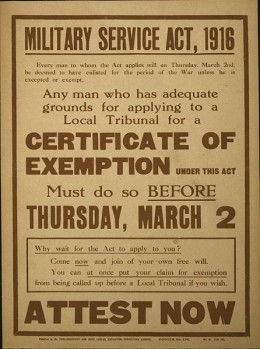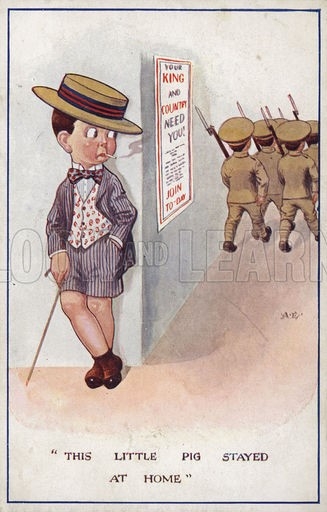Conscientious Objection: We said “No” and that’s that
By the end of 1915, hopes of a swift success on the Western Front had been dashed as British military campaigns continued to fail and the casualties mounted. The German military machine was unrelenting and Lord Kitchener’s ‘war of attrition’ tactic, which relied on throwing as many men at the enemy as possible, meant that Britain needed a constant supply of soldiers. However, despite the rush of men willing to volunteer at the beginning of the war – a year on, the number of volunteers for the army was dwindling and the British government had to take action if they had any chance of winning the war. In January 1916, the Military Service Act was introduced meaning that conscription to the military was to be enforced on all able-bodied men between the ages of 18-41.
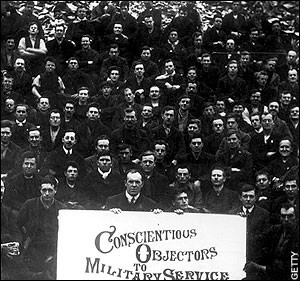
With the introduction of conscription came huge controversy. Not only did this necessitate further sacrifices of men from the already grieving communities, but also the freedom of individuals to have a choice in their stance towards the war. However, the government deemed conscription as essential if Britain was to have any chance of winning the war and it remained in law until the end of the war in 1918.
Local tribunals were set up for men who appealed conscription, a man could be exempted from being called up on grounds of employment in key occupations, family circumstances, poor health or conscientious objection to the war. Conscientious objectors (COs) were men who objected the war on moral, political or religious grounds. Their right to claim exemption from military service had come from the No-Conscription Fellowship and their successful campaign to secure ‘the conscious clause’ in the 1916 Military Service Act.
What were the reasons why men conscientiously objected to the war?
- Religion. This was the most common ground for being a CO. For the Quakers, pacifism was a time-honored tenet and they opposed all wars. Many Quakers registered as COs due to their strong opposition to war, although some did enlist as they believed this would be the quickest way to put an end to the war. There were other religious groups who also opposed the war, including many Christians who took the Bible at its word: ‘Thou shalt not kill.’
- Politics. Left-wing political activists were the next largest group of COs. Socialism was growing in importance in Britain and war was deemed to have no place in a truly socialist society. They saw the war as an imperialist conflict and as an example of the ruling classes creating a war that the workers had to fight – to them, there was no apparent moral purpose to this war.
- Morality. Many people simply felt that killing another human-being was wrong. This was not on religious grounds, but rather their own morality.
- Objectors to government intervention. There was also a group of people who believed that the government should have no intervention in individual people’s lives and objected to being forced to sacrifice their lives for the state.
However, registering as a CO was not a decision to be taken lightly – in fact, refusing to fight on grounds of conscience was an incredibly brave thing for these men to do and those who did faced harsh consequences.
Men who appealed had to do so in public – this was often a very hard process as the tribunals tended to be hostile towards those seeking exemption on grounds of conscientious objection and the men were often subject to trick questions and ridicule. A lot of the tribunals did not see conscientious objection as a legitimate reason for exemption and of the 750,000 cases heard – only 16,000 men were officially registered as COs.
It was not just in the tribunals that the COs faced hostilities. Opposition to the war was a minority view, held and acted upon by less than half of one per cent of eligible men, and many people in British society had an unsympathetic attitude towards ‘conchies’ (as they were known). From early in the war, a campaign of shaming men to enlist by presenting them with a white feather (a symbol of cowardice) had helped create a public perception that all men should be seen to be “doing his bit” – non conformity to this led to mockery. Men were publically ridiculed in the streets as cowards and ‘shirkers’, shunned by their friends and neighbors, and ostracised by their local community.
Yet some faced even harsher punishments. In the eyes of the British government, those who had been rejected on appeal to be a CO were in principle a solider absent without leave and therefore, subject to arrest. COs were also subject to arrest if they refused all compulsory service, over 1,500 men took this stance and they were known as absolutists. They were usually drafted into military units and if they refused to obey the order of an officer, they were court-martialed and faced military punishment. An extreme example of the brutality was the case of the Richmond Sixteen, a group of COs who were sent against their will to France with the Non-Combatant Corps in June 1916 and sentenced to death by firing squad for refusing to obey orders. Although this sentence was immediately reprieved and changed to ten years imprisonment, it is testimony to the bravery of the men who were willing to risk their lives to stand up for what they believed in.
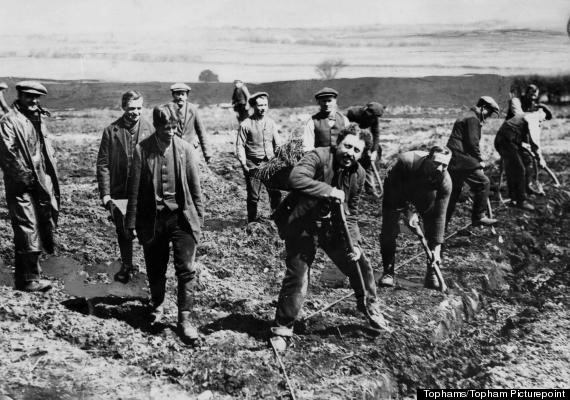
Of the 16,000 COs, over one third of them were sent to prison at least once during the war – including the majority of absolutists who were imprisoned for almost the war’s duration. In prison they were subject to the most severe level of punishments under English law at the time – months of solitary confinement on bread and water, hard labour and field punishments. By the end of the war, a total of sixty-nine COs had died in prison due to the harsh conditions.
It is often forgotten that many of the COs who refused to fight, did agree to perform non-combat service. Around 7,000 men were allocated alternative service such as civilian labour in a farm or factory, or unarmed service in the Non-Combatant Corps or Royal Army Medical Corps. Despite their objection the war, many risked their lives on the front line serving as stretcher bearers which demanded considerable courage under fire.
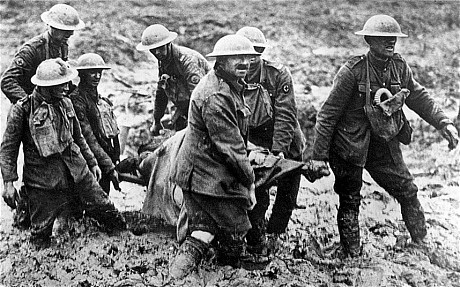
By the end of the First World War, the massive loss of life encouraged the public to have a much more sympathetic attitude with pacifism in the 1920s and ‘30s. With the outbreak of the Second World War in 1939, although conscription was enforced from the start – society had a significantly greater awareness of the legitimacy of conscientious objection and the bravery that it took.
If you would like to learn more about Conscientious Objectors, Margaret Brooks’ article Conscientious Objectors in their Own Words includes both audio and transcripts of interviews with COs about their experiences.
By Abbie Goodwin
Theatre and Community Intern at the Everyman & Playhouse and final year English and Drama student at Liverpool John Moores University
Images used:
Image 1 http://www.telegraph.co.uk/culture/books/non_fictionreviews/3671563/The-...
Image 2 http://www.wakefieldfhs.org.uk/blog/2015/07/east-and-west-ardsley-consci...
Image 3 http://www.lookandlearn.com/blog/28658/during-ww1-some-conscientious-obj...
Image 4 http://www.huffingtonpost.co.uk/2014/02/17/world-war-one-conscientious-w...
Image 5 http://www.telegraph.co.uk/news/ww1-archive/10589311/World-War-One-docum...
Websites used:
http://www.bbc.co.uk/news/uk-27404266
http://www.ppu.org.uk/learn/infodocs/cos/st_co_wwone.html
http://www.telegraph.co.uk/history/world-war-one/inside-first-world-war/...
http://www.hertsatwar.co.uk/conscientious-objectors
http://www.quaker.org.uk/about-quakers/our-history/quakers-and-wwi
http://spartacus-educational.com/FWWconscription.htm
http://www.iwm.org.uk/history/conscientious-objectors-in-their-own-words
